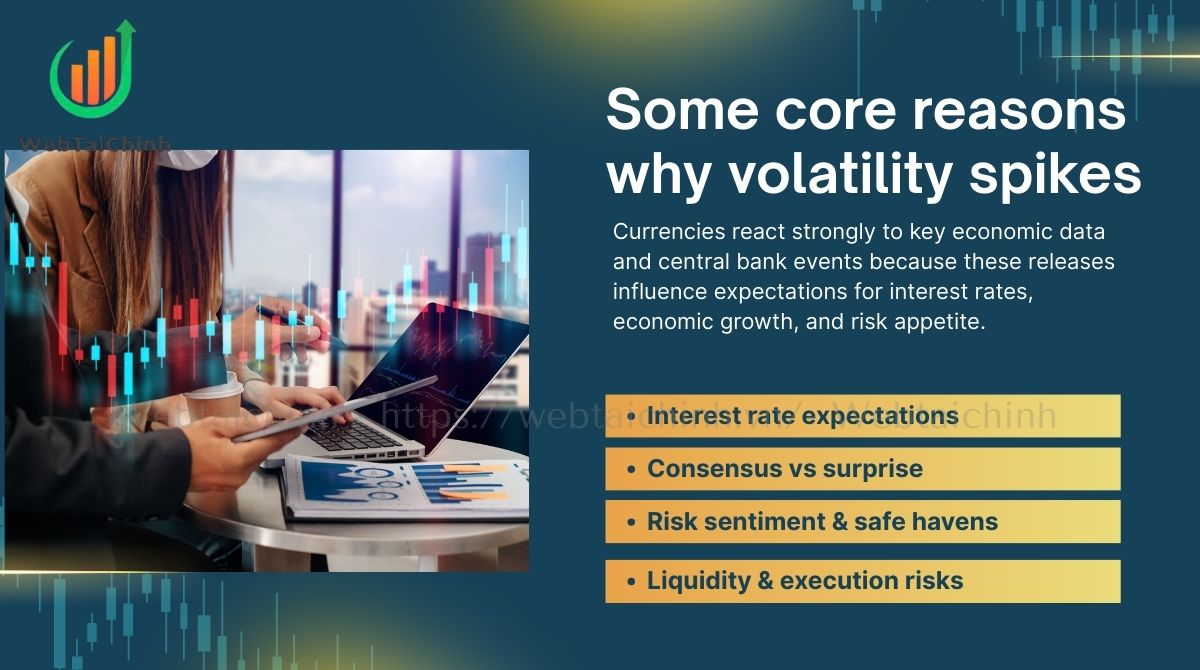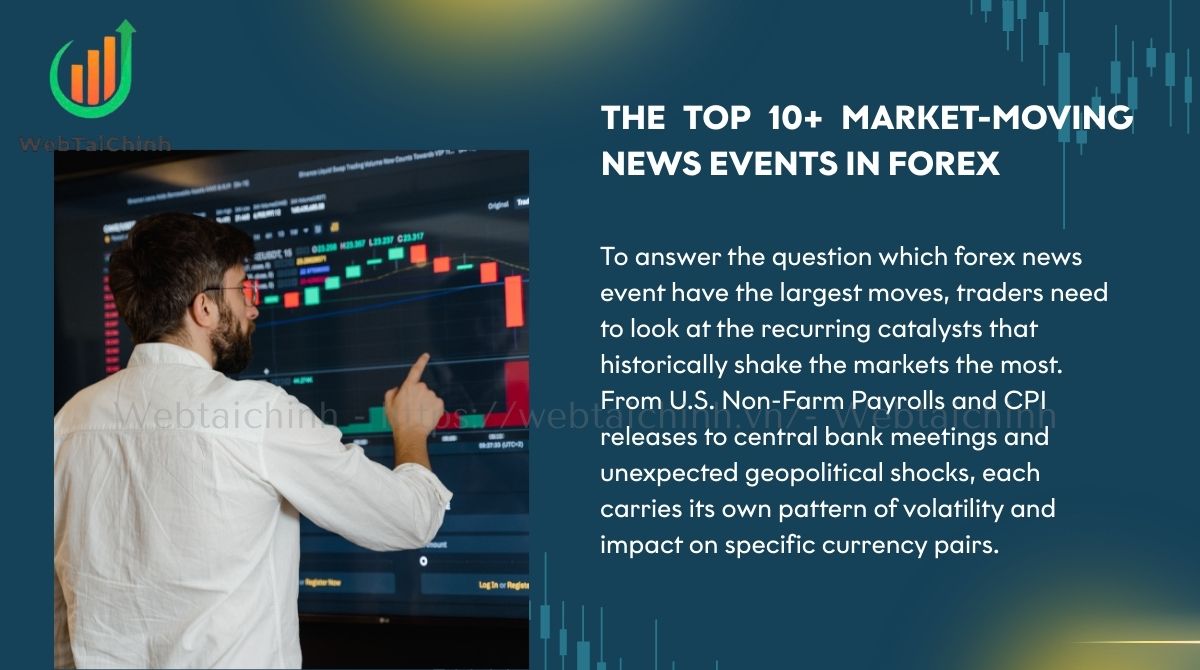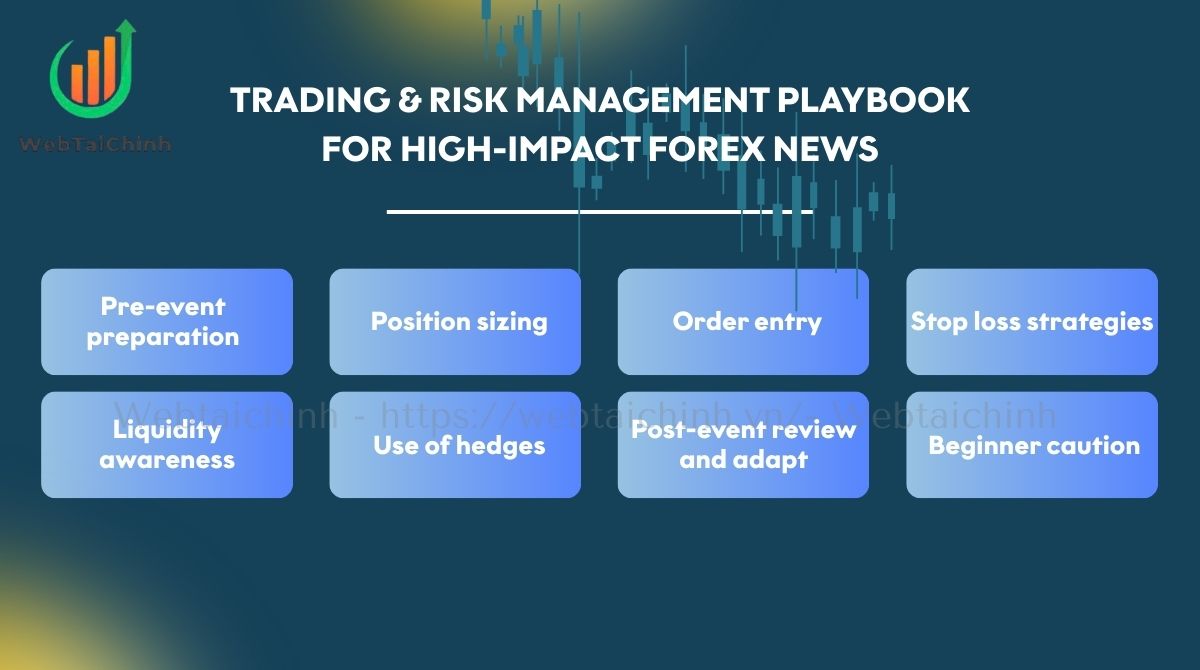Physical Address
304 North Cardinal St.
Dorchester Center, MA 02124
Physical Address
304 North Cardinal St.
Dorchester Center, MA 02124

Have you ever wondered which forex news event have the largest moves and why markets often react so violently to certain announcements? From Non-Farm Payrolls (NFP) to CPI inflation data and central bank decisions, these events consistently trigger rapid price swings that can reshape currency trends within minutes.
Understanding the mechanics behind them helps traders anticipate volatility, manage risks, and position themselves more strategically. This guide breaks down the most impactful news events, explains why they move markets, and offers practical strategies to trade them effectively.
Key takeaways:
Below is a concise comparison table of the top forex news events that traditionally drive significant currency volatility.
| Event | Region | Release time | Why it moves FX | Top pairs affected | Typical impact | Volatility score (1–5) |
| U.S. Non-Farm Payrolls (NFP) | United States | First Friday, 8:30 AM ET | Indicator of employment health influencing rate outlook | USD pairs, especially USDJPY, EURUSD, GBPUSD | High volatility, rapid price swings | 5 |
| U.S. Consumer Price Index (CPI) | United States | Mid-month, 8:30 AM ET | Inflation gauge shaping monetary policy expectations | USD pairs, Gold, EURUSD | Sharp moves on surprise inflation data | 5 |
| Central Bank Decisions (FOMC/ECB/BoE/BoJ) | Global | Scheduled meetings quarterly/monthly | Interest rate changes and policy guidance | Major FX pairs linked to the respective currency | Potentially volatile with policy shifts | 5 |
| GDP Reports | US, Eurozone, UK, China | Quarterly releases | Economic health indicator affecting rate outlook | USD, EUR, GBP, CNY pairs | Moderate to high impact | 3–4 |
| U.S. Retail Sales | United States | Monthly | Consumer spending influencing growth outlook | USD pairs | Moderate volatility | 3 |
| PMI/ISM Indexes | Global | Monthly | Manufacturing and services activity forecast | USD, EUR, GBP pairs | Moderate moves, sudden surprises possible | 3 |
| Unemployment Rate & Wages | Multiple regions | Monthly | Labor market strength influencing policy | USD, GBP, EUR | Moderate to high volatility on surprises | 3–4 |
| BoJ Policy & Yield Curve Control (YCC) | Japan | Irregular, scheduled meetings | Unconventional policy can cause sharp JPY moves | USDJPY, EURJPY, GBPJPY | High impact with surprises | 4–5 |
| Elections & Referendums | Global | Event-driven | Political risk and uncertainty | Varies, depending on country currency | Variable, sometimes extreme moves | 4 |
| Geopolitical Shocks (Wars, Sanctions, OPEC) | Global | Event-driven | Risk sentiment shifts, commodity price shocks | USD, CAD, MXN, Oil-linked currencies | Variable, can cause rapid spikes/drops | 4–5 |
| Oil Inventory Shocks | United States | Weekly (Wednesdays) | Commodity volatility impacts currencies like CAD | USDCAD, USDMXN | Short-term spikes | 3 |
Currencies react strongly to key economic data and central bank events because these releases influence expectations for interest rates, economic growth, and risk appetite. Here are some core reasons why volatility spikes during these events:

Research from the Bank for International Settlements (BIS) shows that forex volatility can rise up to threefold during major announcements. Broker data confirms spikes often last minutes but can set the tone for hours, emphasizing the importance of understanding event-driven mechanics before trading.
To answer the question which forex news event have the largest moves, traders need to look at the recurring catalysts that historically shake the markets the most. From U.S. Non-Farm Payrolls and CPI releases to central bank meetings and unexpected geopolitical shocks, each carries its own pattern of volatility and impact on specific currency pairs.
In this section, we’ll rank and explain the top 10+ events that consistently drive forex price swings, so you can understand not only what they are but also how they affect market behavior in real time.

The NFP report measures the monthly change in US employment, excluding agriculture. It’s pivotal because strong job growth usually signals economic health and influences Federal Reserve rate policy. Released monthly on the first Friday at 8:30 AM ET, NFP often causes fast, volatile moves in USD pairs, especially USDJPY and EURUSD.
Traders watch not only job numbers but also wage growth and unemployment rate within the report. Typical moves can span 50–100 pips or more immediately after release.
A good strategy includes monitoring consensus versus actual, setting wide stops, and avoiding market orders at release to limit slippage. For example, in September 2023, USDJPY surged over 200 pips after an unexpected strong jobs print.
CPI measures inflation rates, a critical determinant of monetary policy. Released monthly around mid-month, surprises in CPI data can radically alter rate hike expectations. The USD and commodities like Gold experience sharp price swings post-release.
Markets pay special attention to core CPI (excluding food and energy) as it’s a better indicator of underlying inflation. Typical volatility ranges from 60 to 120 pips in affected pairs like EURUSD and USDJPY. Traders often use pre-event positioning and option market data to hedge exposure. The strong CPI surprise in 2022 led to notable USD volatility and increased market jitters.
Central bank policy announcements combine rate decisions with forward guidance, decisively impacting currency prices. The FOMC meets approximately eight times per year, ECB and BoE around monthly to quarterly, while BoJ is less predictable due to unconventional policies like Yield Curve Control (YCC).
Market reactions vary – a rate hike usually strengthens the currency while dovish tones weaken it. Pairs involving the respective currencies can see 50+ pip intraday moves, often accompanied by increased spreads and volatile market sentiment. In 2023, unexpected BoJ YCC tweaks caused dramatic USDJPY moves, highlighting execution risks.
GDP measures economic output growth and influences monetary policy expectations. Released quarterly with flash and final estimates, GDP surprises can induce moderate to high market volatility, especially if growth deviates significantly from forecasts.
USD, EUR, GBP, and CNY pairs are notably impacted. Typical reactions last beyond release to reflect broader economic momentum. Traders focus on revisions and sectoral details for clues on future policy.
Retail Sales offer insight into consumer spending, a major GDP component. Monthly releases reveal spending trends and are especially influential if abnormal, signaling shifts in economic momentum.
Moderate volatility is common in USD pairs, with typical moves around 30–50 pips. High retail sales point to stronger growth, supporting the USD.
Purchasing Managers’ Index (PMI) and Institute for Supply Management (ISM) surveys gauge manufacturing and service sector activity. Released monthly, these indexes impact rate expectations by reflecting economic momentum.
Surprises can prompt swift moves in USD, EUR, and GBP pairs, typically moderate in size but with potential for bigger shifts when combined with other data.
This labor market data, released monthly, provides important clues on economic health and inflation pressures. Wage growth figures are increasingly scrutinized for their inflation impact.
These releases cause moderate to high volatility in USD, GBP, and EUR pairs, especially if inconsistent with market consensus.
The Bank of Japan’s unconventional approach, including YCC, makes its meetings unpredictable catalysts. When BoJ tweaks YCC targets or surprises markets with policy shifts, dramatic moves can occur in JPY crosses such as USDJPY or EURJPY.
Liquidity conditions also change sharply post-release, presenting both opportunities and risks.
Political events directly affect currency stability due to uncertainty about future policies. The volatility is highly variable but can be extremely high around key elections or referendums. Traders often reduce risk exposure or use options to hedge against unpredictable moves.
Geopolitical developments influence risk sentiment globally, often triggering safe haven flows or commodity price spikes. For example, oil supply disruptions influence USDCAD and Mexican Peso pairs.
These events cause swift and sometimes prolonged volatility, with reaction size dependent on the scope and perceived longevity of the shock.
Weekly U.S. crude oil inventory updates can cause short-term volatility in commodity-linked currencies like CAD and MXN. Though less volatile than major macro releases, seasoned traders watch for surprises that may affect energy prices and related forex pairs.
Understanding which forex news event have the largest moves is only half the equation knowing which currency pairs react the most is equally important. Different events tend to influence specific pairs more strongly, whether it’s USDJPY surging on NFP surprises, EURUSD reacting sharply to ECB guidance, or oil-linked pairs like USDCAD swinging after OPEC updates.
This section highlights the forex pairs most sensitive to each major news release, helping traders align their strategies with the right instruments for maximum impact.
For example, JPY pairs characteristically spike following BoJ surprises due to the bank’s unique policy stance and Japan’s risk-off appeal during uncertainty.
Forex moves during major news can be grouped into qualitative impact bands:
Key drivers for volatility size include the gap between actual data and market expectations, the tone of subsequent press conferences, unexpected revisions to prior data, and positioning within options markets that can exacerbate quick moves due to gamma and volatility skews. Understanding these drivers helps traders anticipate and manage risks effectively.
High-impact forex news can create both opportunity and danger for traders, depending on how well they prepare and manage risk. Without a structured playbook, sudden price swings and liquidity gaps can quickly turn into costly mistakes.

This section outlines proven strategies from pre-event preparation to post-event review that help traders navigate volatile markets more confidently while protecting their capital.
Retail brokers’ historical data show many retail traders lose money trading during news spikes due to poor risk control and over-leveraging.
Theory is important, but nothing illustrates the power of news-driven volatility better than real-world market reactions. By looking at recent events such as CPI surprises, central bank announcements, and unexpected BoJ policy shifts, traders can see how quickly sentiment changes and how dramatic price movements can be.
This section highlights notable examples where major news reshaped forex markets within minutes, offering valuable lessons for strategy and risk management.
Both cause strong moves, but CPI often has a slightly larger impact due to its direct link to inflation and rate expectations.
EURUSD, USDJPY, GBPUSD, and Gold typically experience the highest volatility.
Trading immediately post-release can be risky; experienced traders wait for initial volatility to subside or use brackets and options.
Use limit or stop orders instead of market orders and reduce position sizes to manage slippage risk.
Generally no; it’s safer to learn and gain experience before trading during volatile news events.
Revisions can be critical as they alter historical data and market expectations, sometimes causing delayed volatility.
Yes, events like ECB decisions or BoJ surprises can move currencies dramatically, especially in regional pairs.
Monitoring via a reliable economic calendar, using demo accounts, and employing prudent risk management strategies are key.
In summary, knowing which forex news event have the largest moves gives traders a clear edge in navigating volatile markets. Events like NFP, CPI releases, and central bank meetings remain at the top of the list for their ability to shift rate expectations and market sentiment instantly.
By studying their typical impact, identifying the most sensitive currency pairs, and applying disciplined risk management, traders can turn high-volatility scenarios into structured opportunities. At Web Tai Chinh, we provide reliable financial insights and timely updates to help you stay ahead of these critical market events and trade with confidence.
Web Tai Chinh is a portal that updates news and information related to finance quickly and accurately, helping users have an overview before investing, clearly understanding concepts and terms related to Finance. Explore more insights in our Forex category, start your FX trading journey today with the right partner for long-term success.
📞 Contact: 055 937 9204
✉️ Email: webtaichinhvnvn@gmail.com
📍 Address: 13 Ho Tung Mau, An Binh, Di An, Binh Duong